Key to Speakers
KN - Kaz Nomura: Co-chair for 55 Plus MinistryRS - Reverend Shinen: Pastor of Sturge Presbyterian Church
KKH - Kimi Kodani Hill - author
LC - Leonard Chan - recorder and interviewer
PC - Philip Chin - interviewer and transcriber
FH - Florence Hongo - interviewer and owner of AACP
RS - I want to again say welcome on behalf of the church and this is the first time for you here? This is co-sponsored and I think Mrs. Hill is going to say something about that about that...co-sponsored by... some of you have the flier here. We have Asian American Curriculum Project and I think... let's see.
KN - Florence Hongo, Japanese American Curriculum Project, and she is co-sponsoring together with 55 Plus Ministry. And she's providing the refreshments.
RS - Flo? Are you here?
KN - Yes, Flo?
RS - Sitting in back. So I think after the presentation is done, after that's all over there's some books in the back.
KN - Right.
RS - Actually I'm probably repeating everything you're going to say.
KN - No, no, no, no. That's fine. That's fine. (Laughter)
RS - But welcome again. And this is sponsored, as I mentioned earlier, this is sponsored by the 55 Plus Ministry of this church, Sturge Presbyterian Church and I want to also tell you that tomorrow we're having a church picnic and you're all welcome to come. We going to the park at 11 o'clock and if you want to come to church service of course at 9:30, you can do that, dress casual just as I am today. Then we'll walk...actually drive to the park tomorrow. So we're really happy to have all of you here, especially Mrs. Hill, and we're looking forward to hearing from her. So if you wouldn't mind, if you'd join me in prayer and we'll begin our program.
Loving God, we thank you for history. We thank you. You are the God of history. That you are in the past, and present, and in the future. We thank you God for the events of our lives that have shaped us to be who we are. But more importantly, that your intervention and your supremacy and sovereignty in our lives have helped us through some of the most difficult parts of our journey. Many of the people sitting in this room this afternoon I know have been through difficult years in the past and I think as they watch some of these slides and hear some of the comments being made will relive some of their history, some of them pleasant some of it not so pleasant. But I pray through it all that they might be able not only to retrace their steps but to know of your goodness and your graciousness to them. And Lord would you bless Mrs. Hill this afternoon as she shares these photographs, pictures with us, and commentary. And we pray that you lead her that it might touch us in a very significant way today. Thank you that we are able to gather and be together this afternoon. We pray this in your name. Amen.
KN - 55 Plus Ministries purpose is to have an outreach to many of our contemporaries as well as to the younger generations of our church. Today we are presenting Topaz Moon: Chiura Obata's Art of the Internment. We have other programs in the works that we hope you'll attend in future meetings. We'll let you know more about those. We're presenting today's program with Flo Hongo of the Asian American Curriculum Project.
When Flo called me to say that we would present this program at this church I was very excited because I to was incarcerated in Tanforan and then in Topaz, Utah. I was at that time an eighteen-year-old freshman at UC Berkeley. Chiura Obata was the famous professor at the university, already known for his artwork. The only thing we had in common was our Japanese surname. When I think back, it was actually...really 58 years ago, almost to the day in September that all of us at Tanforan Racetrack, now called the Tanforan Shopping Center, were getting ready to move from our horse stable home to go to Topaz, Utah. We were bussed to the Southern Pacific terminal in Oakland, and as we entered coaches we noticed that all the blinds were drawn. The MP's instructions were do not to look out the windows. We were not to know where our destination was. This was the atmosphere as we left our Bay Area homes.
Now this was the beginning of our internment experience. Each person journeying was quite unique and different, and today you will hear the experience of Chiura Obata and his family as told to you by his granddaughter, Kimi Kodani Hill. So, Kimi, come up.
KKH - Thank you. Thank you very much. There are two free seats right up front if anyone wants to sit up closer. Just yell out if I'm not speaking loud enough. So, it's a pleasure to be here today. I have been giving talks, lectures on my grandfather for the past several years now. In conjunction first with the publication of "Obata's Yosemite," which Flo brought copies of today if you're interested in. But, this year was incredibly busy, I gave maybe over twenty talks within three months in conjunction with the publication of Topaz Moon, which was a grant recipient of the California Civil Liberties, Public Education Program. I was very lucky to receive the grant and be published on time. We did a lot of public programming to get the word out about the book.
The Slide Show and Lecture
KN - We'd like to welcome you to our special program today. I'm Kaz Nomura, co-chair for our 55 Plus Ministry. We hope that you will find our program today informative, reflective, and interesting. To begin our afternoon we have our pastor, Reverend Shinen open our program with a prayer. Reverend Shinen?
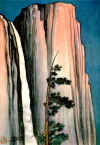
Evening Glow at Yosemite Falls, 1930.
Color woodblock print, 15 3/4 x 11 in.
From Obata's Yosemite, page 127
Picture 1
And the philosophy that he would teach his students, because he was a professor of art, follows along these lines. I will give you an example. Here he is lecturing and you can see he's written the words, wa, kei, sei, jyaku. These are... a philosophy most closely associated with tea ceremony, the Japanese tea ceremony. But he would explain these words, harmony, respect, purity, serenity in these terms. This is a quote from him, "Harmony should include the family, the town, and the country. Without it much trouble comes. We must respect what nature provides; fire, water, earth, sun, even the simple weeds. Often if we take these away we make much trouble. Cleanliness means that we must purify the senses that nature gives us so that we can appreciate the pure sounds and colors that she provides. Tranquility is important. If your mind is not smooth and calm you miss so many things."
Now he spent a total of 65 years of his life living and painting in California. What I am going to do today for you is give you a broad biography of his life. And just as a little background, the reason I became, you know, wearing this mantle of Obata family historian, it just sort of happened by fate if nothing else, is that I was living with his wife, my grandmother, for the last ten years of her life.
I... this is me here. Here I am. My sister, my father, and this is Chiura Obata, my grandfather. I'm perturbed with these fish. I didn't really like them at all.
I just grew up taking my grandparents for granted. I thought everyone had a grandfather who painted and a grandmother who did ikebana, flower arrangement. It wasn't until after he passed away, he passed away in 1975, and then I began to be the primary caretaker, living with my grandmother, from the age of... when she was 87 to when she died at 97 years old. During that time I went through the house, looked at photo albums, asked questions. I did hours of oral history with her.
It was this period after my grandfather had died that I finally felt I had gotten a sense of who he was. This is what I'm presenting to you today is partly what I discovered. For instance, just the physical things that the family had kept. These are documents and letters from 1942, 1943. You can see this address, Professor Obata, care of the Art Department UC Berkeley, crossed out and replaced with the address at Topaz, Utah. So my grandparents were packrats to be sure but he in particular kept so many documents from the wartime and he knew that at some point in the future these would become important for history. Basically the text of Topaz Moon is based on the archival material in the family and the interviews and oral histories I was able to do. Very very lucky I was able to do all these things. This was about 15 years ago.
So, feel free to call out if you have any questions. Am I speaking loud enough? Can everyone hear me?

Zoroko Obata with grandmother, Isoko,
and father Rokuichi. ca 1891.
From Topaz Moon, page 3
Picture 2
This is a scene from Northern Japan. They were from the Sendai area, so the snowy winters up there. Yet, he also was trained in Western art, so this is an example of the training he had as a student in Tokyo in the 1880's. And, he continued to paint throughout his life with the Western influence. So this is a sketch that he made of his own watercolor materials. This is a Western watercolor box, not the traditional Japanese watercolors. Again, a nice example of the... He was a prolific artist. He insisted on painting a sketch or painting everyday of his life. And he would just sketch everyday scenes so this is a nice typical scene, 1900's in Japan, the influence of course with the little pinafores of the West coming in with the traditional kimono.
So, Rokuichi was not actually Chiura Obata's teacher but ... this is of course the household that Obata was growing up in with this art and an artist father. This is a portrait Rokuichi painted of Chiura when he was about six years old. And this is the first Obata painting that I've been able to find. He was maybe about eight years old when he sketched this samurai guy. (Laughter)
Obata was training from age seven with a master painter in the art of sumi painting. This is an example of an assignment, probably, because he received a grade. So this red mark is the grade that he got for this assignment. So he's learning brush technique, how to handle the brush, and the different gradations of the sumi ink, the different grades.
As it turned out he was a very headstrong child. He had a lot of conflicts with his father and his family. He ran away from home at age fourteen to avoid being put into military school. He was determined to be an artist. He managed to become apprenticed under this particular artist, his name is Tanryo Murata. And his father did finally give approval. So Obata spent three years in an apprenticeship in Tokyo. He was studying with other students. This is a nice sketch from Obata's sketchbook from this time. So we're talking about 1900 now. And the hakama that they were wearing when they went sketch outdoors. He lived at the studio. He had a real apprentice's life. Already this sketchbook at age 16 he was showing his ability with the brush. Especially with this very fine detailed sketch.
By the way you'll be able to see that sketchbook in this exhibit. It's amazing to me to give this presentation and think that we do have this opportunity to see a lot of these materials. So be sure to look at the cases because there will be actual artist materials and old sketchbooks in there.
So he left the apprenticeship at age seventeen. This is, apparently it's a formal costume for an artist, traditional costume. He took this photograph. And he received commissions right away. They were usually on historical subjects. This is a sketch that he is preparing for a finished painting. And the only finished painting I've seen, that is still in existence, I've seen it. It's in Japan. And it's...this is it.. its of Uesugi Kenshin, who is... was a famous feudal lord in Yonezawa and was a commission. It is absolutely signed and dated by Chiura Obata when he was commissioned to do this at age seventeen.
Now he also, around the same time, received a very prestigious award, an art award in Japan, in Tokyo. And he told his father that Japan was such a small country to have given this prestigious award to such a young artist. He really wanted to see the world. He told his father, "The greater the view, the greater the art, the wider the travel, the broader the knowledge." And he was able to get permission to travel. His goal actually was Europe, Paris, because a lot of his compatriots were already studying art in, you know, the capital of the art world, which was Paris at the time. But he planned to get there via America by earning some money and then continuing.
Here is Obata and here is his father, Rokuichi, and members of the family. And we're pretty sure this portrait was taken because he would be leaving soon. And as it turned out, because as you know it took weeks to get from Japan over to the United States at that time, he would never see his father again. Here is Obata again. Farewell portraits that were taken.
Oh, and his passport. Passports that all the issei all had to get, which you can read, he was "disinfected" in Yokohama before getting on the boat. It took two weeks of travel by ship and the port of entry for Obata was Seattle.
This is a letter that he wrote back to his father looking through the porthole and seeing America for the first time. And he said in this letter, "How lucky I am that I can sleep on the pillow of a foreign pier. Is this god's gift or the spirit of man?" And he arrived eventually in San Francisco. He had some letters of introduction. The Pine Methodist Church helped him find lodging and he was able to work as a schoolboy. So as a domestic in a household. And what he's done. You can see, he's written his name, "Chiura" with the implements of his life now as a houseboy.
And in this, in a letter he wrote at this time to his father back in Japan, he explained, "I said, 'Good morning, do you need a boy?' I repeated those words. I was successful. I felt strange but at the same time I was glad. From 6 to 8:30 in the morning and from 4:30 to 8:30 I will help the Missus. I will have a bedroom, three meals, and a wage of $1.50 a week. The rest of the time is my own. This is the merit of being a schoolboy." You can see the same sketchbook and he's written, "How do you do?" November 1903. He's just been in America for one month now, living in San Francisco. And portrait of the cook at Thanksgiving.
I think probably a lot of you have seen the manga, the comic book, "The Four Immigrant's Manga." And... which shows the history of the same time and they, Obata and Kiyama, were actually friends and knew each other. They experienced many of the same things as schoolboys and living in San Francisco. Another letter, he wrote, "The head looks like it is stuck in a bottleneck. If they drop something they cannot bend their necks."
But Obata himself began transforming into part of American society. This is also... I've been showing these letters that he wrote back to Japan. This is one that came from Japan from his father, a sketch of the family home in Sendai and the dogs that were Obata's dogs. So Obata was becoming part of American society, he wrote, "It is essential to learn American art and its spirit. Therefore, I'd like to free my future brushwork through the means of language study first." And he did. He tried seriously studying English wherever he could. Even... joining an elementary school. Also, one of the first new loves of his life in America was baseball. He was one of the founders of the Fuji Club, the first... Japanese-American baseball team on the mainland in America. He is the pitcher here. There... and another...Yeah, that's the second one, 1911, there's Obata with the Fuji Club.
The big, first big event in his life was the 1906 earthquake. He survived the earthquake. Apparently the chimney fell down in his room in Japantown where he was living and apparently the story is that a lot of the refugees ended up at Lafayette Park in San Francisco. He was asked... a group of men were asked to dig a hole for a latrine and when the Army officer returned, Obata was the only one still digging away and so he said, 'Oh, you're a good boy. I will reward you by giving you a job at the Grand Marshal's camp to wait on tables.' And they also gave him permission to go into the ruined section of the city to sketch and so we have these very rare sketches of the aftermath of the San Francisco earthquake. And... there will be at least three of these on exhibit at the exhibit. He's labeled all of them, so you can tell where he is. This is Van Ness Avenue for instance. And they're very small. They're only this big, but they're very detailed. And this one looking across the Bay to Mt. Tamalpais from probably the Marina area.
And here he is around 1910, Obata, with his issei cohorts, hanging out. Earning money was pretty difficult for the immigrants at this time as you probably know. And he did take a job as a farm laborer at one point. This was in 1909 and he worked at the hops fields in the Sacramento Valley. He said, "This morning we got up at dawn and right away we started to pick hops. No matter where you go earning money is not easy. Working thirteen hours standing only makes two dollars. From tonight the gambling called naga-imo has begun. The people are making noise under the moonlight. This lonely mountain town has nothing but hop fields. The pure moon shines a beautiful light equally over fields, mountains, grassbeds, and gambling." It's hard to see but there is like a crescent moon that he painted in the sky there. And the moon appears again and again throughout Obata's career in his artwork. It symbolizes, I feel, for him hope and eternity and peace.

Haruko and Chiura Obata.
San Francisco, ca 1912
From Topaz Moon, page 4
Picture 3
Now Haruko, just to say something about her, because everyone says, 'Well you really should talk more about your grandmother,' and it's true. She was just as much an artist as my grandfather but her art was ikebana, so it was ephemeral, there's nothing that has survived from her art obviously, in contrast to all the paintings that have survived from my grandfather's long career. She made thousands of arrangements. She was one of the first teachers of ikebana in the San Francisco Bay Area. As early as 1915 she had an exhibition of her flower arrangements at the Panama Pacific Exposition in San Francisco. And here's an example of a very early flower arrangement show. Flower show. And a picture of San Francisco Bay from about 1919.
Now, as you know the 1910's, 1920's, the blatant prejudice shown against the Japanese community was something that all the Japanese-American community had to deal with. And my grandparents were no exception. My grandfather had physical encounters on the streets of San Francisco because he'd be walking down the street and he'd be hit or attacked or spat upon simply because of his ethnicity. And yet ironically at the same time there was this interest in japonisme or the 'Oriental Arts,' and stores like Gump's and the City of Paris all commissioned Obata to decorate their Oriental rooms to sell their Asian arts. So there was... my grandparent's realized early on that teaching arts to the Americans was a way to teach about Japanese culture and they really strove through their whole lives trying to create a bridge of understanding between Japan and America, between the two cultures through teaching their art forms. This is an example of some of the early illustration work that Obata was receiving. This is a travel magazine to Japan in 1921. A picture of Van Ness Avenue. In the early... apparently in the middle of the street is an Italian fisherman selling his wares. And a portrait of the diva of a production of 'Madame Butterfly' of which, in 1924, Obata was commissioned to design the set for this production. And so as I mentioned, they realized that the Americans appreciated Japanese art. They only needed to be taught more about their culture.
Obata tried different techniques during his career as an artist but basically he worked with the traditional Japanese materials. So just to show people, this is a suzuri, the sumi stick, which is ground to create the black ink. And then just some of the wide variety of brushes that a sumi painter would use. These are the materials that he would work with. And he created artworks really from his own studies. He tried to take a class in an American art academy, the San Francisco Art Institute actually, and he was so, you know, horrified by the lack of discipline shown by the students that he felt he could learn much better on his own and he did. He studied art virtually on his own for his whole career and he did try different styles. This is a style known as nihonga which was popular in Japan at the time, incorporating Japanese painting with Western influences. And you have a great opportunity to learn more about the kind of technical descriptions of this at the De Young Museum. The curator has written a beautiful brochure which will be free to the public. You can take it home.
And you know I'm afraid that this slide is backwards. But anyway, this painting is a very interesting story. It's actually a portrait... its the only nude portrait of my grandmother. And she was already pregnant... four months pregnant. And he said, "I'm going to paint this picture of you." And she said, "No, no, I don't think so." And he said, "Every artist's wife poses for their husband in the nude." (Laughter) She finally relented. She did have hair down to her knees. She used to pile it up on her head. And he titled this, 'Mother Earth.'
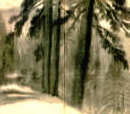
Untitled (Alma, Santa Cruz Mountains),
29 November 1922.
Sketchbook, sumi on silk mounted on
Boards, 14 1/4 x 16 1/2 in.
From Obata's Yosemite, page 24
Picture 4
Now in 1927, was a key event in Obata's life as an artist, his career. It was the first meeting of Obata with Yosemite, in particular the High Sierras. He was invited by Worth Ryder, who was a professor of art at UC Berkeley. They had become friends. Different American artists were getting to know Obata's work and through his exhibitions. At the time Obata was 42 years old, so this was his perfect moment in time, his ability as an artist had fully matured. He even said that this experience of this trip... He said, "This event was the greatest harvest for my whole life and future in painting." And what he did is he also wrote letters back home describing for my grandmother who...of course she's at home with four kids while the husband is out having this artistic experience. And these letters form the text of 'Obata's Yosemite,' the other book that we have brought for you to look at today.
So they traveled on the Old Tioga Pass Road, which is Highway 120, for those of you who know the pass through Yosemite. And they were traveling in a Model T Ford on the old Tioga Pass Road, which was a dirt road, so this was truly an adventure. And here he is on this trip.
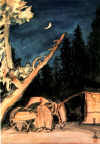
Untitled (Camp),, 1927.
Sumi and watercolor on paper,
15 3/4 x 11 in.
From Obata's Yosemite, page 84
Picture 5
There was a third member who was camping with the group, a young artist named, Robert Howard. He wrote of camping with Obata and said, "Afterwards, before turning in for sleep, Obata would bring forth his philosophies of life. How to remain young. How to appreciate every minute of existence and time. How right it was to be happy, and cheerful, and productive. How wrong to shed tears, do nothing, and waste time and strength. That to be an artist was the best of all things."
The first exhibition Obata had for American audiences was in the following year, 1928. You can see that he is sketching on the... doing a painting demonstration on the ground with Haruko assisting him. And as it turned out the last day of the exhibition his father passed away in Japan, which entailed that the entire family would go back to Japan, Obata being the only son of this family. This is just again... the exhibition I just told you about. The San Francisco Call and Post (newspaper)... you know the degree of sophistication in American society at the time. You have to remember that they didn't know very much about Japanese art, Asian art, so this comment is so interesting to me. "This happens to be the headwaters of the San Joaquin River, a very odd piece of work." And this is the painting they're referring to, which doesn't seem odd to me at all. But it's not the typical, you know, oil painting, traditional American art style that people were used to viewing their landscapes.
So the family returned to Japan. Here is Obata, Haruko, oldest son Kim, and Gyo, there's my mom, Yuri in the Sendai house. Kim was already a high school student. He didn't want to go to school in Japan and he left the family soon after they arrived, about several months later to come back to San Francisco and continue his high school education at Galileo in San Francisco.
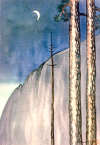
Evening Moon, 1930.
Color woodblock print, 15 3/4 X 11 in.
From Obata's Yosemite, page 15
Picture 6
After two years.... And here is Haruko, the Western looking one, with her friends in Tokyo saying goodbye. They returned to San Francisco and this period, from 1930 was Obata's introduction to the California art scene. He had many exhibitions. They were very successful. This was an article in the Oakland Tribune and this was an exhibit that he had in 1931 at the California Palace of the Legion of Honor, a big exhibit with both his work and the work of his father, Rokuichi. This painting is... I'm happy to announce is being purchased by the De Young Museum to be part of their permanent collection. And the curator is determined that when the De Young Museum reopens in 2005 that Obata will not be ignored as he has been for so many decades and that this painting will be on view for people who visit the De Young. This is a... It's great...It's just... it's just been really exciting for me to work with a curator who feels that there were artists definitely who were overlooked who should now be given recognition in the American art scene.
In 1932, Obata was invited by his friends at UC Berkeley to lecture at the art department, which led to a permanent position as a professor of art at UC Berkeley. This is Telegraph Avenue. I know there are several UC grads here, or people who went to UC. But this is Telegraph Avenue and the Sather Tower. While they were living in Berkeley, Haruko had her own busy schedule teaching ikebana. She's shown in this San Francisco Chronicle article 1935 with Mrs. Dean Witter at the California Garden and Flower Show. And Obata enjoyed painting her arrangements. These are some of the best records we have of the work she did. Another ikebana.
He also enjoyed painting the Berkeley scene. This is looking across....this is the Golden Gate Bridge and Mt. Tamalpais from the Berkeley Hills. The campus.
He said in the late 1930's, "I always teach my students beauty. No one should pass through four years of college without being given the knowledge of beauty and the eyes with which to see it." He was a very popular teacher. A former student...actually several students have told me that he was not just teaching a style of painting, the sumi painting style, but he taught a way to observe, a way to see and appreciate the beauty of nature. He always brought his students to the out of doors on campus to paint and sketch. This is...these are a quote from his lectures. He said, "Anything in art is like yourself. In the long run it is a way of living. Many things come. Many things happen. You make happiness, morning or evening, sunny morning or dark night. You know how you felt. How is the emotion felt? What kind of feeling of harmonization did you have? Feel deeper what kind of step it took toward harmonization. If you took too short a step next time take a longer step. Use a deeper stride. Take steps like a cow. Don't fall down so easily."
The students just responded so positively to his classes. They were very popular. This is another quote. He said, describing talking to his students, "I said I would go to the Santa Cruz Mountains to watch the autumn moon. My students said, 'If you just want to see the moon, you don't have to go that far, you can see it from here.' So this is the point. You go to the Santa Cruz Mountains and in those deep mountains you wait for the sunset and you hear the sounds of the bellsinger cricket and then slowly from behind the woods the moon emerges. That atmosphere is beyond expression. I feel this is the blessing of Great Nature."

A Storm Nearing Yosemite
Goverment Center, February 1939.
Sumi on silk, 20 7/8 X 32 5/8 in.
From Obata's Yosemite, page 43
Picture 7
The...just as a note of explanation cause you live close enough to Monterey, you probably go down there sometimes. In Point Lobos Park there's a small museum and it talks about the Kodani family who fished for abalone. So that's my paternal side of my family. So the two men, two grandfathers were friends and Obata would go hang out and paint right in this Whaler's Cove area. Kodani ran an abalone fishing industry there in Point Lobos. And these are....so this is my mom with my dad and the Obata brothers and then the Kodani family and the divers. This is the guesthouse that the Obata used to stay at. These are the Kodani grandparents. But it says here, you can't read it, says, "Artist's Cottage." So my grandfather was not the only Japanese artist who was visiting this area and they often stayed at the Kodani house. This is what the interior looked at... looked like because the artists would leave their art there as thank you's for staying there. So it's a point that I'd like to make is that there was a lot of appreciation for the arts even amongst these first immigrant families. You'd think everybody is out there just slaving away but they actually really did appreciate the arts. Unfortunately we don't know where... what happened to a lot of these paintings, of course, because of the war.
And another nice view of Point Lobos. The moon in Point Lobos. And I believe that one will also be in the exhibit. I'm running overtime, should I just keep going? You guys OK? Trying not to rush it too much but there's a lot of beautiful work to see.
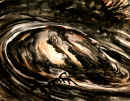
Landslide 1941.
Sumi and watercolor on paper, 22 X 28 in.
From Topaz Moon, page 113
Picture 8
They... as with all families of course, were allowed to bring only what they could carry in this climate of this racial hysteria that was going on. I like to show this picture (war propaganda poster) because I think you know people don't realize how blatant the racism was during that time. What was this... What did that image have to do with these people, right?
This is the Obata family. Again, my mom and the two Obata boys just a few years before the war. This is the notebook that my grandmother had just trying to keep track of everything they were packing up, all the kitchen dishes, and Yuri's music books. They were going to Mrs. Crawford. They were very lucky that they had so many friends within the university community. Students and friends were storing things for them. They also sold a lot of things for almost nothing. They actually had a store. They had to close the store down.
The Alien Registration Card that all issei had to carry. This is for Haruko. This is an example of the papers from that time... the wartime.
The departure for the Berkeley Japanese, there were about 1200 who left Berkeley, the departure happened at what was called the First Congregational Church, ironically the church where Kim and Masa Obata had been married a few months before.
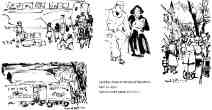
Sketches made on the day of departure.
April 30, 1942.
From Topaz Moon, page 23
Picture 9
This was his farewell to the Bay Bridge, symbolizing this breaking from their past to this unknown future. And landing in the horse stables at Tanforan with all this mud that had been created cause of these rains. The Obata family walked into their designated barracks which was a converted horse stable. There was nothing there accept the cots and the lightbulb and my grandmother apparently sat down on this cot and just cried. My mother never saw her mother cry ever before in her life.
Everyday life with the mess hall lines.
From the very first day that Obata was in Tanforan he conceived of an idea to create an art school. He firmly believed in the power of creativity to raise the spirits of his fellow internees. And what he was able to do was to get his fellow artist friends, Matsusaburo Hibi for one, who were in the camps, interned in the camps, and the recent UC graduates or people who had not even graduated yet who were in architecture or art classes. And within a month they were able to create an art school that had 600 students. They had no funding from the government. They did it entirely with their own money and with donations from the outside from friends from UC Berkeley. This is a children's class that he was teaching in Tanforan. And the school was so successful that they were able to exhibit the artwork outside the camp just a month later in July. This is an Oakland Tribune article on the exhibit. This is at Tanforan.
Some of the people would come to visit the internees and couldn't get passes to get in so they would meet at the fence. My grandmother remembered some of the women students from Berkeley would come and she said, 'Oh they would cry, poor things,' they would say, "Oh Professor Obata, you are behind the fence!" And he would answer, "From my perspective it looks like you are behind the fence!" (Laughter)
And as was mentioned earlier, the transfer from Tanforan to Topaz happened right about now, this time of year, end of September into October. It was the Boy Scout band from San Francisco. They would be out there everyday in the heat and the dust doing this welcome. This is your new home.
And yet these works are very repetitive in recording what is going on and yet they are also making these little political statements. Here he was careful to include... They are still building the barracks as people are arriving to the camp. And the barbed wire fence which was one of the first jobs the internees had when they arrived at the camp was to finish building this barbed wire fence that would enclose them for the next three years.

Dust Storm
ca 1943
From Topaz Moon, page 120
Picture 10
This art school continued at Topaz. It thrived very well even though the internees had virtually no materials to work with. So they were just picking up every kind of stick and firewood out in the desert to try to create some crafts and works of art. My grandmother in particular had so much trouble doing ikebana that she would actually ask her friends back in Berkeley to mail camellia branches to her so she would have some materials to work with and then her students would make the actual flowers out of crepe paper and attach it to the camellia branches.

Topaz War Relocation Center
by Moonlight ca 1943
From Topaz Moon, page 121
Picture 11
Now in the Spring of 1943 was the very tense time in the camp with the signing of the controversial loyalty oaths. My grandfather was attacked because of this period. He was seen as pro-administration because he worked so closely with the administration as director of the art school. He walked out the shower one night and was whacked in the head. He stayed for two...two weeks in the Topaz Hospital and then he was immediately released by the administration who wanted to be sure he would be safe. While he was in the hospital this incident occurred. Wakasa, an issei man, was walking close to the perimeter fence and was shot and killed by a guard. It was a huge event, a controversial event that happened in the camp. Also this painting will be on display at the exhibit. I should explain that this exhibit is about the landscapes of Obata but there is going to be one separate room which will have the camp paintings. And it's one reason the curator chose the word 'transcendent' that Obata was able to transcend the situation through his artwork. So please be sure to check out the separate room while you're at the exhibit.

Devastation 1945
Watercolor on paper, 13 X 18 1/2 in.
From Topaz Moon, page 134
Picture 12
So he returned to Berkeley. He was immediately reinstated by the University in 1945. The Obata family was very lucky that the relocation back home was not as difficult as many many families had coming back to California. He stayed with friends before they could finally find a little apartment. He is around sixty years old when he's teaching at Cal again. This little apartment they had, that they lived in for several years before they could find a house, it was so small that my mom, who dated my dad now at Cal, she would sleep on the couch and my grandparents would pull a Murphy bed out of the wall every night. Remember those old apartments?
And Obata returned to his favorite places to paint. To Yosemite. To Point Lobos. This beautiful painting of Point Lobos. Thinking I am sure of his many issei friends who did not survive the war years. For instance, Mr. Hibi, died soon after the war. Many other friends. And he would call this "Glory of Struggle" thinking again of the life of the tree equaling the lives of the issei.
Haruko was busy doing her ikebana again. Here she is in San Francisco giving a demonstration, around 1950. And then I've mentioned the fishing part of the Obata's. This is something I even remember is going to the beach and Obata... my grandfather would be out surf fishing hauling this heavy gear around. He would take his students out from UC Berkeley. He taught there until 1954. So he'd say we going to take a sketching tour, a sketching class and he would fish while they would sketch. (Laughter) And they would have a good picnic and so here is Obata and Haruko and my mom and some students and their families and friends.
Early picture. This is a much earlier picture of a successful catch. Striped bass. He fished right out at Baker's Beach and Pacifica. Those were favorite places. I think I have a picture of Baker's Beach. Another leaping for the strike. He spent so much time out on the water that he had so many pictures of the water and the atmosphere. Here we are, this is Pacifica, I think. But this is unusual cause he painted himself into the painting. There's his friend.
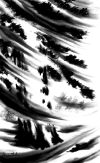
Glorious Struggle 1965
Sumi on Silk, 36 X 22 in.
From Topaz Moon, page 111
Picture 13
Okay, see what I have...I'm just going to bring us up to date. The middle son I mentioned, Gyo, later became the head designer of a firm called Hellmuth, Obata, Kassabaum. Most of you know it as H-O-K. His most famous building was the Smithsonian Air & Space Museum that he designed in Washington DC. But HOK has done a lot of projects here in the Bay Area including PacBell Stadium. But he also designed the Japanese-American National Museum and some of you may have seen this already in Los Angeles. It's a very nice building and I encourage you to go there and check it out sometime.
And Topaz, well for you who have already been there, because you were forced to be there, for me it was a really extremely interesting fascinating trip to go there and see this site. There's nothing there in that you have to interpret what you see. There's nothing higher than your knee level. It's all in the ground. But there is a lot you know. You just have to... OK this is a tree, one of these trees they planted that of course died as soon as they couldn't water it anymore. There's tons of nails and boards and things just sitting out on this high desert because it's a very dry atmosphere so nothing is deteriorating out there. That's Mt. Topaz in the distance and I'm standing in the area of about Block 9 where my grandparent's were living. This is the actual concrete pad for the mess hall where the Obata family took their meals in Block 9. Again, like I said, these boards are still sitting in there on the ground because the barracks weren't on concrete pads. They were just sitting into these slots of this wood so this is the foundation of the barracks, these pieces of wood. And the barbed wire fence is still there. It's amazing. So, if not yourself, encourage your family members to see this history. It's still there after sixty years.
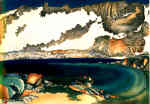
Lake Basin in the High Sierra, 1930.
Color woodblock print, 11 x 15 3/4 in.
From Obata's Yosemite, page 61
Picture 14
Thank you. I know I went very long here today but thank you very much. You're a great audience.
(Applause)
KN - Thank you Kimi. We got much more than we bargained for. (Laughter) It was just wonderful. But I think as she spoke she certainly made it such that we appreciate nature a great deal more. I know I have and I also am happy that you were able to organize the De Young exhibit for your grandfather because I certainly think he is a great artist. I just wanted to say that you certainly are a wonderful historian for your family. What you did for us today was just wonderful... Thank you.
